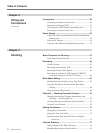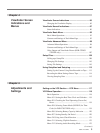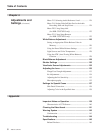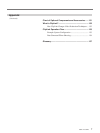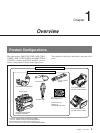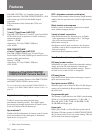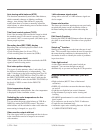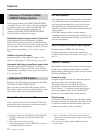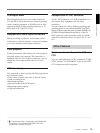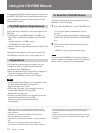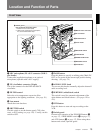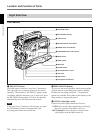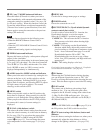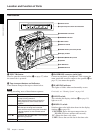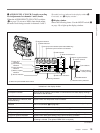
Chapter 1 Overview
12 Chapter 1 Overview
Features
Features of the DSR-570WS/
570WSP Camera Section
Following are features of the DSR-570WS/570WSP,
considered only as a 16:9 wide screen type camcorder.
For features which are common with the DSR-370/
370P 4:3 standard screen type camcorder, see
“Features of the DSR-370/370P/570WS/570WSP
Camera Section” on the previous page.
Switchable between aspect ratios 16:9 and 4:3
Menu operations allows instantaneous switching
between 16:9 (wide screen) and 4:3 (standard screen)
aspect ratios. In 4:3 mode, 16:9 video signals produced
by wide aspect CCDs are digitally processed to extract
the section corresponding to a 4:3 screen (see page
105).
Addition of aspect ID signal
By menu settings, a wide-aspect ID signal
1)
can be
added to video signals
2)
in 16:9 mode (see page 105).
Automatic switching of viewfinder aspect ratio
When the supplied DXF-801/801CE viewfinder is
used, the scan size of the viewfinder screen switches
automatically to match the current aspect ratio (16:9 or
4:3) (see page 105).
Features of VCR Section
Features of the VCR section are common to the DSR-
370/370P and DSR-570WS/570WSP.
The camcorder uses the DVCAM recording format.
The internal signal processing is digitalized to provide
more stable output signals and higher reliability.
Compatible with consumer DV
A DV cassette recorded on a DV-format VCR can be
played back on the camcorder. (Cassettes recorded in
LP mode cannot be played back.)
DVCAM cassettes
• This camcorder can use both standard-size and mini-
size DVCAM cassettes. According to cassette size,
the camcorder automatically corrects reel position.
• The maximum recording/playback times are 184
minutes for standard size cassettes and 40 minutes for
mini cassettes.
• DVCAM cassettes include a cassette memory.
Information about the editing points (ClipLink™ log
data) that is specified while shooting is recorded into
this cassette memory.
Able to record the external video signals
Fitting the optional DSBK-501/501P Analog
Composite Input Board enables the camcorder to
record external analog video signals. (See pages 27, 64
and 93.)
ClipLink™ function
The ClipLink function links all stages from shooting to
editing. Once editing points have been set with this
function during shooting, they can be used to boost the
efficiency of editing work.
Creation of clips
Using the ClipLink function, the camcorder operator
can create clips to be used during editing.
The images captured at the Mark IN points are
recorded in a compressed format onto the tape as
“Index Pictures”
3)
. In addition, editing point-related
data (scene number, time code for Mark IN/OUT
points, etc.) is recorded in the cassette memory.
ClipLink mode
To use the ClipLink function, select the menu setting
to set the camcorder into ClipLink mode. There is also
a ClipLink continue function that enables clips to be
continued even after a break in recording.
..........................................................................................................................................................................................................
1) ID signals complying with EIAJ CPR-1204 (DSR-370/
570WS) or complying with ETS WSS (DSR-370P/
570WSP).
2) Video signals refer to the following:
• Video signals output from the VIDEO OUT connector
and MONITOR OUT connector.
• The Y component of Y/C separate signals and the Y
component of component signals output from the VTR/
CCU connector.
3) It is necessary to fit the optional DSBK-301A Index
Picture Board.



